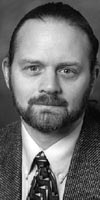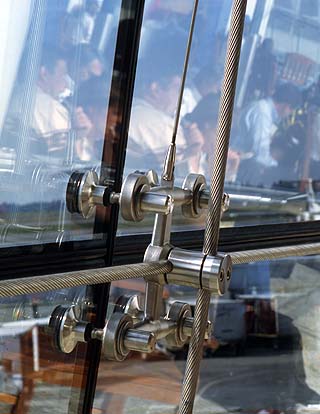|
Subscribe / Renew |
|
|
Contact Us |
|
| ► Subscribe to our Free Weekly Newsletter | |
| home | Welcome, sign in or click here to subscribe. | login |
Construction
| |
 |
June 30, 2005
An engineer's-eye view of the terminal

|
MIKE BRAMHALL
Firm: ABKJ
Position: Project manager
Project staff: 7 engineers, 3 drafters
What sort of seismic design did the project call for?
The architect wanted the space inside the Pacific Marketplace to be as free and open as possible. So for the lateral force-resisting system we selected a unique moment frame system using trusses and large steel columns.
The project also included the seismic upgrade of the original administration building directly to the east, which employed a combination of steel bracing and new concrete shear walls.
The ticketing-level floor diaphragms in three areas — the Central Terminal, the administration building and the passenger terminal to its east — were stitched together so that the new Central Terminal portion could be used to buttress the other two buildings.
This was highly unusual but necessary since available locations for upgrade elements in the existing structures were virtually nonexistent.
Why was the glass wall such a challenge?

Photo courtesy of Matt Todd Photography
A net of tensioned steel cables supports the Central Terminal’s 350-foot-long glass wall. Cast aluminum ‘spiders’ mount the glass onto the net.
|
The wall is about 60 feet high and about 350 feet long. What makes it unique is the fact that it is doubly curved — concave vertically and convex in plan.
Unlike a typical window wall system that uses a system of aluminum mullions or trusses to support the weight of the glass and resist wind loads, this wall is supported on a net of tensioned steel cables. Each cable is tensioned to an average of about 29,000 pounds. In high wind it is anticipated that the middle of the wall will deflect 6 to 10 inches each way.
The glass is mounted on the cable net using cast aluminum "spiders" that clamp onto an intersection of a vertical and horizontal cable and attaches to the corner of four separate panes of glass.
The most difficult aspect of the structural design was the impact of the cable tension on the relatively light-weight roof trusses.
How did you work around all the airport activity?
Airport activity consisted of many different stakeholders such as baggage handling, facility maintenance, police department, passengers, office personnel, FAA personnel and so on.
An extensive plan of scheduled utility shutdowns and area closures was prepared by the contractor, architect and the Port of Seattle to ensure that the process went as smoothly as possible.
Some of the measures included wood partitions, a temporary steel bridge over the northwest corner of the excavation, and the infamous wood-framed tunnels that led travelers from the central security checkpoint to concourses B and C.
What was the most interesting problem?
It is very hard to pinpoint a single item, but one that sticks out for me was the area known as the Delta bag room. This space was originally built with Concourse B in 1963, but was slated to be removed for the terminal expansion.
In essence, we needed to erect a three-story steel structure over a fully operational baggage handling area without allowing exposure to the elements.
In addition, in one corner of the original area was an FAA room with critical vibration-sensitive equipment that could not be disturbed under any instance. In another portion, there was a number of ceiling-hung utilities and conveyors that had to remain operational even though the ceiling they were supported by was to be removed and replaced.
We handled these difficulties using a top-down method of construction and delicate retrofitting of existing framing members rather than removing and replacing them.
Much of the planning was worked out during a series of meetings between the Port of Seattle, the architect, the structural engineer, the contractor and their steel erection subcontractor.
What's your favorite part?
My favorite part of the project is the exposed king-post roof trusses.
There are a number of ways to bridge the 100-foot clear span of the Pacific Marketplace, but the light and simple nature of these exposed elements is, for me, such an elegant solution to the architect's vision and the significant constraints of the location.
Did you learn any lessons?
Among other things, this project is a sterling example of how flexible the design and construction process can be.
This would have been a difficult building to build if it were on its own. But we erected the framing and installed the myriad of utilities, equipment and finishes while dealing with the construction, logistical constraints, multiple stakeholders and numerous unforeseen existing conditions.
It's a testament to the hard work, dedication and willingness of all those involved.
Compiled by staff reporter Jon Silver, who can be reached by email or by phone at (206) 622-8272.
Other Stories:


